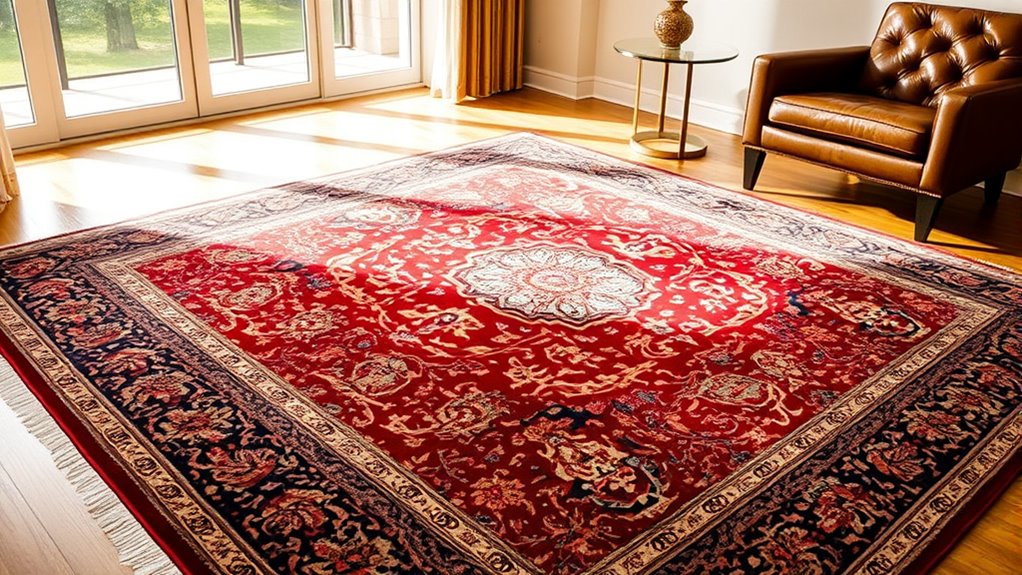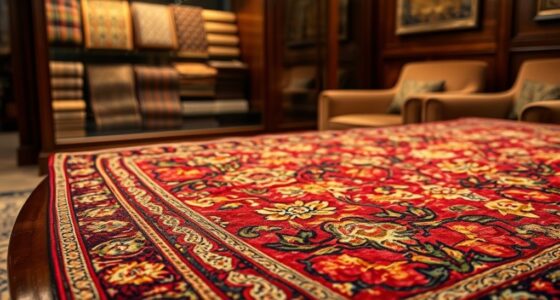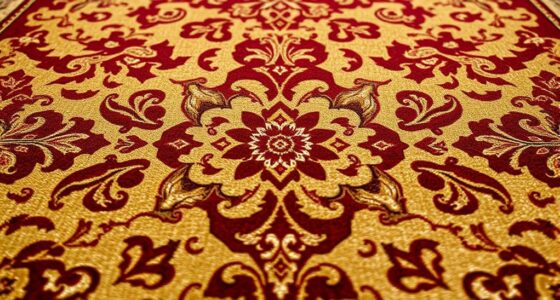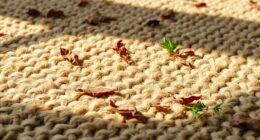To protect your rug valued over $25,000, you should consider specialized insurance policies like fine art or collectibles coverage that account for its craftsmanship, provenance, and age. Confirm the policy provides thorough protection against theft, damage, natural disasters, and accidental harm, with replacement at current market value. Avoid common mistakes like underinsuring or not updating coverage. For tips on maintaining and documenting your collection, keep exploring how to safeguard your investment effectively.
Key Takeaways
- Obtain specialized art or fine property insurance policies that explicitly cover high-value rugs over $25K.
- Ensure the policy provides full replacement cost at current market value, including coverage for theft, fire, and natural disasters.
- Regularly document your rug’s condition, provenance, appraisals, and repair history to support claims and verify value.
- Update your coverage after any renovations or changes in your rug’s estimated worth to avoid underinsurance.
- Work with experienced appraisers and insurance agents to tailor coverage specifically for your valuable rugs.
Understanding the Value and Appraisal of High-End Rugs

Have you ever wondered what makes a high-end rug truly valuable? It all comes down to craftsmanship, materials, age, and provenance. Expert appraisers assess these factors to determine a rug’s worth accurately. They examine the quality of the dyes, the intricacy of the design, and the condition of the fibers. Age can add value, especially if the rug is rare or historically significant. Provenance, or the rug’s history, also plays a vital role—authenticity and previous ownership can increase its worth. To guarantee you have an accurate appraisal, work with certified experts who specialize in high-end rugs. Their evaluation provides the foundation for insurance coverage, helping you understand what your rug is truly worth and how much protection it needs. Additionally, understanding how AI technology can assist in provenance verification and condition assessment is increasingly becoming part of the appraisal process.
Types of Insurance Policies Suitable for Expensive Rugs
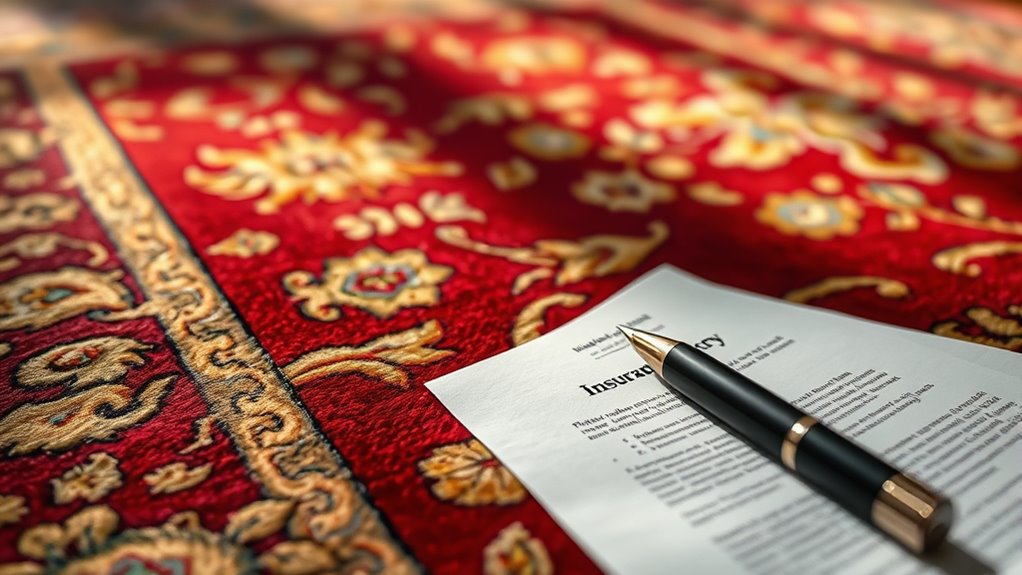
When insuring a high-end rug, selecting the right policy is key to guaranteeing proper protection. You want coverage that addresses the unique risks associated with valuable textiles. Consider these policy types:
- Specialty Art and Fine Property Insurance: Tailored for valuable collectibles, including high-end rugs.
- All-Risk Homeowner’s Insurance: Offers broad coverage, often expandable to include rugs.
- Rug or Art-Specific Policies: Designed specifically for high-value textiles, providing detailed protection.
- Collectibles Insurance: Suitable if your rug is part of a valuable collection.
- Premium Personal Property Coverage: Offers enhanced limits and specialized protections for luxury items.
- Understanding Insurance Policy Options can help you choose the coverage that best fits your needs and ensures your investment is protected against theft, damage, or loss, giving you peace of mind.
Key Coverage Features to Look For in Rug Insurance
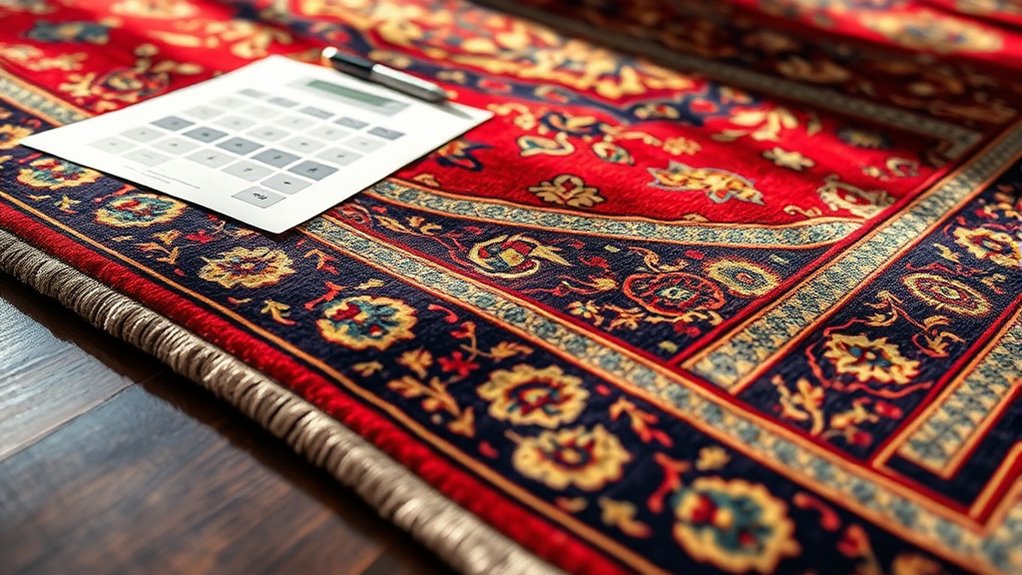
What key coverage features should you prioritize in rug insurance to guarantee your valuable piece is fully protected? First, ensure the policy offers comprehensive coverage that includes both accidental damage and theft. Look for a plan that covers restoration costs or replacement at current market value, not just the initial purchase price. It’s also vital to confirm that the policy covers the full appraised value of your rug, especially if it’s unique or antique. Additionally, check if the coverage extends to damage caused by natural disasters like floods or fires. Make sure the policy specifies clear claims procedures and provides prompt payouts. Finally, consider coverage for specialized cleaning or repairs, which can be crucial for maintaining the rug’s condition over time. Being aware of the value assessment process can help you better understand how your rug’s worth is determined and ensure appropriate coverage.
Common Mistakes When Insuring Valuable Rugs
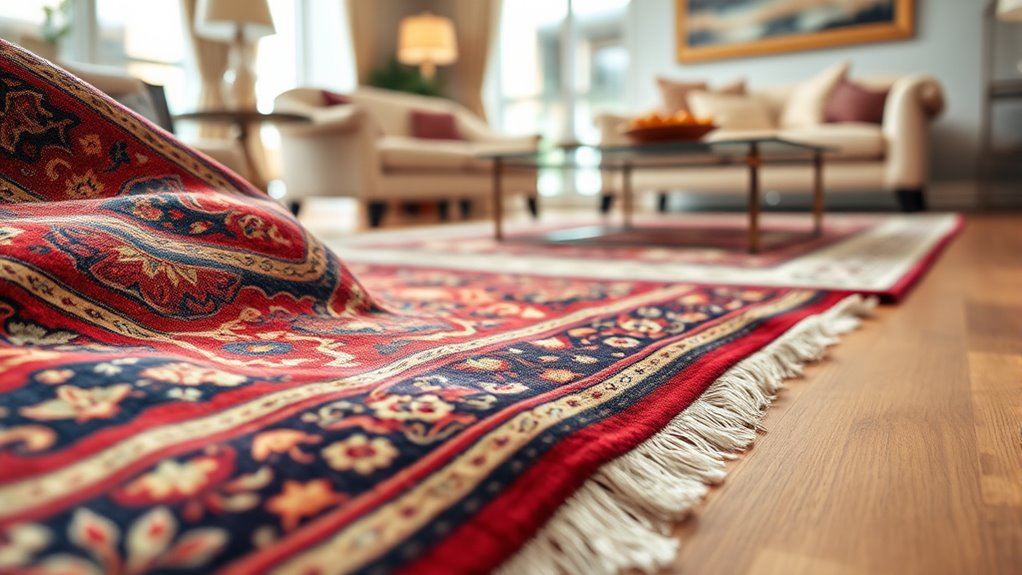
Many owners make the mistake of underinsuring their valuable rugs, which can lead to significant out-of-pocket expenses if a loss occurs. Underestimating a rug’s true value or failing to update coverage after renovations can leave you vulnerable. Additionally, relying solely on standard policies without verifying specific coverage for high-value items increases risk. Neglecting to document your rug’s condition and provenance can complicate claims. Finally, choosing a policy with limited coverage or high deductibles can diminish your protection when you need it most. Regularly reviewing your policy and understanding your coverage options can help ensure your valuable rugs are adequately protected.
Tips for Maintaining and Documenting Your Rug Collection
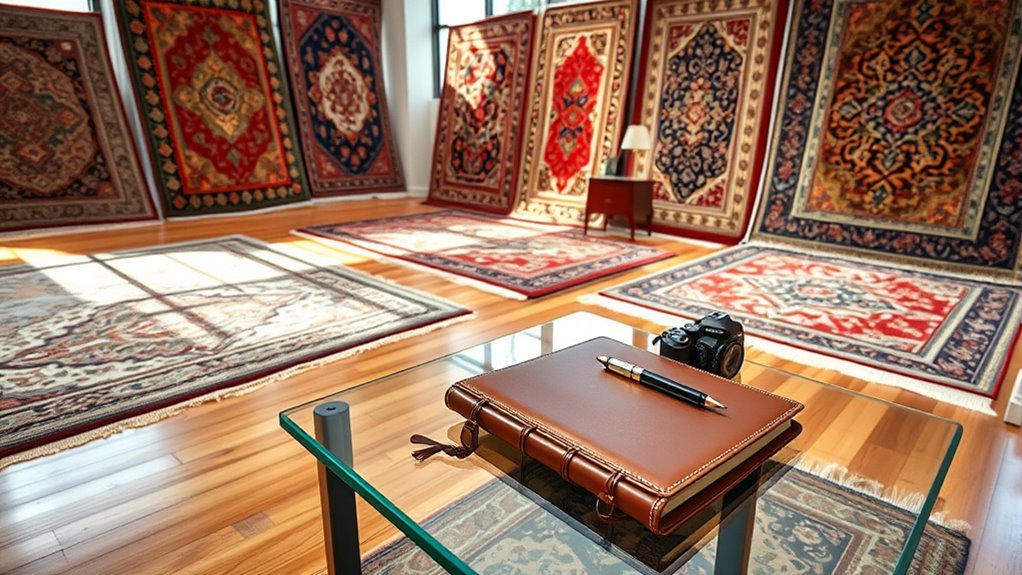
Maintaining and documenting your rug collection is essential to preserving its value and ensuring smooth claims if damage occurs. Regularly clean your rugs using gentle methods suited for their materials, and avoid harsh chemicals. Rotate rugs periodically to prevent uneven wear and fading. Keep detailed records, including photos from multiple angles, appraisals, receipts, and cleaning or repair histories. Store these documents in a safe, organized location—digital copies are highly recommended. Consider creating a catalog with descriptions, dimensions, and any unique features for each rug. This thorough documentation not only helps verify authenticity and value but also streamlines the insurance process during claims. Proper maintenance combined with detailed records safeguards your investment and provides peace of mind. Additionally, understanding regional divorce statistics can help you better assess the value and importance of safeguarding your collection against unforeseen circumstances.
Frequently Asked Questions
How Often Should I Reappraise My High-Value Rugs?
You should reappraise your high-value rugs at least every 3 to 5 years, especially if you notice changes in their condition or market value. Regular appraisals guarantee your insurance coverage stays accurate, protecting your investment. Additionally, consider reappraising after any significant damage, cleaning, or restoration work. Staying proactive helps you avoid underinsuring or overinsuring, giving you peace of mind and proper financial protection.
Does Standard Home Insurance Cover Damage to Expensive Rugs?
Standard home insurance might cover some damage to your expensive rugs, but it often has limits, especially for high-value items. You could face deductibles or partial reimbursement, which may not fully cover repairs or replacements. To guarantee your valuable rugs are protected, consider a specialized rider or policy add-on. Review your coverage carefully, and talk to your insurer about options tailored to high-value possessions.
Are There Specific Exclusions I Should Watch for in Rug Policies?
A stitch in time saves nine. When reviewing rug policies, you should watch for exclusions like wear and tear, accidental damage, or specific perils like floods or earthquakes. Standard coverage often doesn’t include these, so read the fine print carefully. You might need specialized coverage or riders for high-value rugs. Don’t assume all damages are covered; understanding exclusions helps you avoid surprises later.
How Does Insurance Handle Loss Due to Natural Disasters?
When a natural disaster causes damage, your insurance typically covers the loss if you have a thorough policy. You’ll need to file a claim promptly, providing evidence of the damage. Keep in mind, some policies have exclusions for certain events like floods or earthquakes, so verify your coverage details. It’s wise to review your policy and consider additional coverage for specific natural disasters to guarantee your valuable rug is fully protected.
Can I Insure Rugs That Are Not Currently Displayed or Stored?
You can typically insure rugs that aren’t currently displayed or stored, but it depends on your insurer’s policies. You should inform your provider about the rugs’ existence and location, even if they’re not in use. Providing detailed descriptions and photos helps. Some policies may require you to update your coverage if the rugs move or are stored elsewhere. Always check with your insurer to guarantee proper protection.
Conclusion
So, you’ve invested over $25k in rugs—smart move, right? Just remember, leaving them unprotected is like inviting a tornado to a glassware store. Insure wisely, document meticulously, and maintain diligently. Because nothing says “I’ve got my act together” like stressing over a spilled cup of coffee on your priceless masterpiece. Protect your treasures now, or someday, you’ll be crying over spilled—well, you know. Don’t gamble with your rug’s future; insure smartly and sleep soundly.
